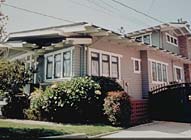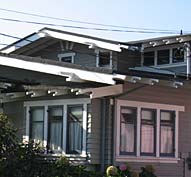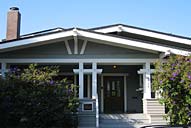




2424 Fourth St.


John W. and Anna George House,
2424 Fourth Street, 1910

detail

Front view
“The bungalow was practical, and it also symbolized for many the best of the good life. As easterners came west, they found bungalows waiting for them … and they built more. In fact, the great sprawl of the city of Los Angeles is as much testimony to the popularity of the simple little house set in its garden as it is to the fad of the automobile, which itself is a kind of extension of the single-family dwelling. … The feeling of independence [the bungalow] gave, even on a tiny plot of land, is part of the freedom which even today one senses in Southern California.”
Craftsman style bungalows usually have these features:
• Low-pitched roof
• Wide eaves with exposed roof rafters
• Decorative braces
• Porch with square columns
• One or one and a half stories
• Built-in cabinets, shelves, and seating
Many Craftsman bungalows also have:
• Stone chimneys
• Gabled dormers
• Sloping foundation
The Craftsman Bungalow is an American housing style, but it has its spiritual
roots in India. Native houses in the province of Bengal were called bangla
or bangala. British colonists adapted these one-story thatch-roofed
huts to use as summer homes.
The first American house to be called a bungalow was designed in 1879
by William Gibbons Preston. Built at Monument Beach on Cape Cod, Massachusetts,
the two-story house had the informal air of resort architecture. The form
was embraced by two California architects, Charles Sumner Greene and Henry
Mather Greene. Their bungalow designs represented structural simplicity,
efficient use of space, and understated style. Most of the living area
is placed on the ground floor.